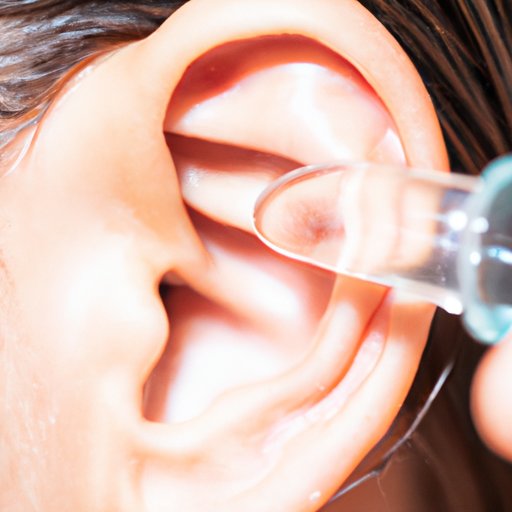
Introduction
Have you ever gone swimming or taken a shower, only to feel water trapped in your ear for what seems like an eternity? It’s not only uncomfortable, but it can also lead to infections if left untreated. In this article, we’ll cover different methods for removing water from the ear, so you can get back to feeling like yourself again.
Step-by-Step Guide
The following are different techniques you can try at home to remove water from your ear.
Tilt Your Head to the Side
One of the easiest methods for removing water from the ear is to tilt your head to the side and let gravity do the work. Place a towel or tissue against your ear to catch any water that may come out. Gently pull your earlobe in different directions to help the water drain out.
Use the “Valsalva Maneuver”
The “Valsalva maneuver” involves closing your mouth and nose and gently blowing air through your nose to equalize the pressure in your ear. Be mindful not to blow too hard, as this can cause damage to the eardrum. Repeat as necessary until the water drains out.
Try Using Ear Drops
Over-the-counter ear drops that contain alcohol or a mixture of alcohol and vinegar can help evaporate the water in your ear. Tilt your head to one side and place a few drops of the solution into your ear. Let it sit for a few minutes before tilting your head to the other side to let the solution and water drain out.
Tips for Avoiding Water Getting Trapped in the Ear in the Future
Prevention is key when it comes to avoiding water getting trapped in your ear. Some tips to keep in mind include:
- Use earplugs or a swim cap when swimming, showering, or bathing
- Dry your ears thoroughly after swimming or showering by tilting your head to each side or using a blow dryer on low heat
- Avoid inserting cotton swabs or other objects into your ear, as this can push the water further in and increase your risk of infection
Video Tutorial
If you’re more of a visual learner, check out this video tutorial on how to remove water from the ear:
Expert Advice
In some cases, it may be best to seek expert advice from a medical professional or audiologist to ensure that there is no damage to your ear or risk of infection.
Advice from a Medical Professional or Audiologist
A medical professional or audiologist can perform an ear exam to determine if there is any damage to your ear or if an infection is present. Based on their assessment, they may recommend different treatments, such as earwax removal, antibiotics, or other medication.
Recommendations for Further Treatment if Necessary
If the water in your ear is due to an infection or other underlying condition, additional treatment may be necessary. Be sure to follow your healthcare provider’s recommendations and attend any follow-up appointments as scheduled.
Personal Experiences
Many people have experienced water getting trapped in their ear at some point in their lives. Here are some tips and techniques that have worked for others in similar situations:
Common Remedies That May Work for You
- Chewing gum or yawning to help equalize the pressure in your ear
- Using a warm compress, such as a warm towel, over the affected ear
- Using a blow dryer on low heat to help evaporate the water from your ear
Listicle
Here are some additional ways you can try to remove water from your ear:
5 Ways to Remove Water from Your Ear
- Use a mixture of hydrogen peroxide and water to clear wax buildup and water at the same time.
- Create a vacuum with your hand over your ear and carefully push it back and forth several times to move the water out.
- Use medical-grade ear drops that are designed to remove water from the ear safely and quickly.
- Try the “to-and-fro” method by tilting your head forward and gently pulling on your earlobe while hopping on one foot.
- Use a rubber bulb ear syringe to flush your ear canal with water to dislodge the water trapped inside.
Conclusion
Water in the ear can be uncomfortable and even lead to infections if left untreated. The methods outlined in this article provide different options for safely and effectively removing water from your ear. Remember to try different methods and seek expert advice if necessary to promote ear health and prevent future episodes of water trapped in the ear.





